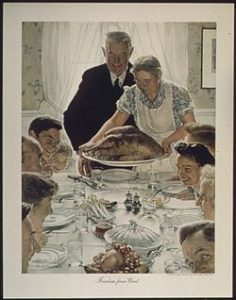
Freedom From Want, Norman Rockwell, 1943, oil on canvas, source: https://en.wikipedia.org/wiki/Freedom_from_Want_(painting)
Like many of Norman Rockwell’s paintings, Freedom From Want (also known as The Thanksgiving Picture) idealistically reflects traditional American values. The value most prominently reflected in this painting is family. The work consists of a group of people, likely a family, gathered around the table for a meal. The creases in the tablecloth, showing that it is not used often, and the types of food present show that it is likely a holiday meal. At the head of the table stand the patriarch and matriarch of the family. The matriarch wears an apron showing that she was likely the one who was doing the cooking. She stands presenting a cooked turkey to her family while the patriarch looks on with fondness and approval. The wide variety of ages of the figures, from the young girl on the far end of the left side of the table to the white-haired woman on the right side of the table, shows that this would be a family, not a group of friends and that it is a multi-generational family. Overall, work reflects the importance and value of family in traditional American culture.
